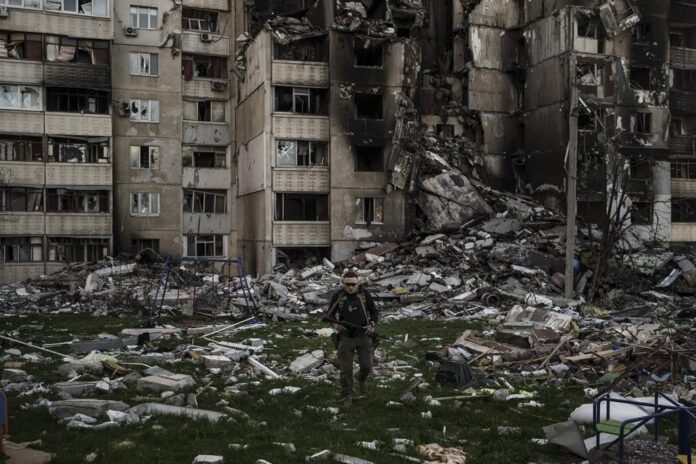Ukrainian forces reported battlefield gains on Wednesday in a counterattack that could signal a shift in the momentum of the war, while Kyiv shut gas flows on a route through Russian-held territory, raising the specter of an energy crisis in Europe.
Following days of advances north and east of the second largest city Kharkiv, Ukrainian forces were within just several kilometers of the Russian border on Wednesday morning, one Ukrainian military source said on condition on anonymity. Before the advance, Russian forces had been on the outskirts of Kharkiv, a city 40 km (25 miles) from the frontier.
The advance appears to be the fastest that Ukraine has mounted since it drove Russian troops away from Kyiv and out of the country’s north at the beginning of April. If sustained, it could let Ukrainian forces threaten supply lines for Russia’s main attack force, and even put rear logistics targets within Russia itself within striking range of Ukrainian artillery.
In Vilkhivka, a village east of Kharkiv held by Ukrainian forces, the thump of near-constant artillery and swoosh of multiple rocket launchers could be heard from fighting at the front, now pushed substantially further east, where Ukraine has been trying to capture villages on the banks of the Donets river and threaten Russian supply lines on the far side.
On Wednesday evening, Ukraine’s general staff said its forces had captured Pytomnyk, a village on the main highway north of Kharkiv, about halfway to the Russian border.
Further east, Ukrainian forces seemed to be in control of the village of Rubizhne, on the banks of the Donets.
“It is burned out, just like all Russian tanks,” a Ukrainian soldier told Reuters near Rubizhne next to the ruins of one Russian tank. “The weapons are helping a lot, the anti-tank ones.”
Families reunite in Kyiv after evacuations due to Ukraine war
KHARKIV ADVANCE
Kyiv has so far confirmed few details about its advance through the Kharkiv region.
“We are having successes in the Kharkiv direction, where we are steadily pushing back the enemy and liberating population centers,” Brigadier General Oleksiy Hromov, Deputy Chief of the Main Operations Directorate of Ukraine’s General Staff, told a briefing, providing no specifics.
Trending Stories
Canada’s defence minister says the world is ‘growing darker’ and ‘more chaotic’
Fugitive Alabama prison officer dies after police capture escaped inmate in Indiana
President Volodymyr Zelenskiy said successes were putting Ukraine’s second-largest city — under constant bombardment since the war’s early days — beyond the range of Russian artillery. But he cautioned Ukrainians against raising their expectations too high yet.
“We should not create an atmosphere of excessive moral pressure, where victories are expected weekly and even daily,” he said in an overnight video address.
In Vilkhivka, the advance had made it possible for residents to venture back to comb through the wreckage of their homes. Although the village itself had been recaptured by Ukrainian forces weeks ago, the frontline was only now far enough away to make it safe to return.
The bloated body of a Russian soldier still lay moldering outside the bombed-out school where his unit had made its headquarters before being driven out.
GAS SUPPLIES
Wednesday’s separate move by Ukraine to cut off Russian gas supplies through territory held by Russian-backed separatists marked the first time the conflict has directly disrupted shipments to Europe.
Shipments from Russia’s export monopoly Gazprom to Europe via Ukraine fell by a quarter after Kyiv said it was forced to halt all flows from one route, through the Sokhranovka transit point in southern Russia. Ukraine accused Russian-backed separatists of siphoning supplies.
Should the supply cut persist, it would be the most direct impact so far on European energy markets of the war that the Kremlin calls a “special military operation.”
Russia says it sent troops into Ukraine to demilitarize a neighbour threatening its security. Ukraine and its allies say Russia is waging an unprovoked war of conquest that has killed thousands, destroyed towns and cities and driven close to 6 million people out of the country.
Newfoundland and Labrador welcomes 1st Canadian airlift of Ukrainians
Apart from the east, Russia has seized a swathe of southern Ukraine, where Kyiv and its Western allies say they believe Moscow intends to organize a fake referendum on independence or annexation to make its occupation permanent.
The Kremlin said on Wednesday it was up to residents living in the Russian-occupied Kherson region to decide whether they wanted to join Russia, but any such decision must have a clear legal basis. Earlier, TASS news agency quoted an official in the Russian-controlled administration as saying the region planned to ask President Vladimir Putin to incorporate it into Russia.
Russian forces have also continued to bombard the Azovstal steelworks in the southern port of Mariupol, last bastion of Ukrainian defenders in a city now almost completely controlled by Russia after more than two months of siege.
Ukraine’s general staff said Moscow was trying to capture the steelworks. The Azov Regiment holed up inside it said Russia was bombing from the air and trying to storm it.
Read more:
Russian official claims U.S. ‘directly participating’ in Ukraine fight as ‘Victory Day’ nears
“Azovstal is on fire again after the bombing. If there is hell on earth, it is there,” wrote Petro Andryushchenko, an aide to Mariupol’s Mayor Vadym Boichenko, who has left the city.
Kyiv says it is likely that tens of thousands of people have been killed in Mariupol. Ukrainian authorities say between 150,000 and 170,000 of the city’s 400,000 residents are still living there amid the Russian-occupied ruins.
“Without medicine and medical care, the restoration of the water supply and proper sewerage in the city, epidemics will erupt,” said the mayor. “Today, the majority of the current population is old and sick. Without proper conditions, mortality among vulnerable groups will increase exponentially.”
© 2022 Reuters



